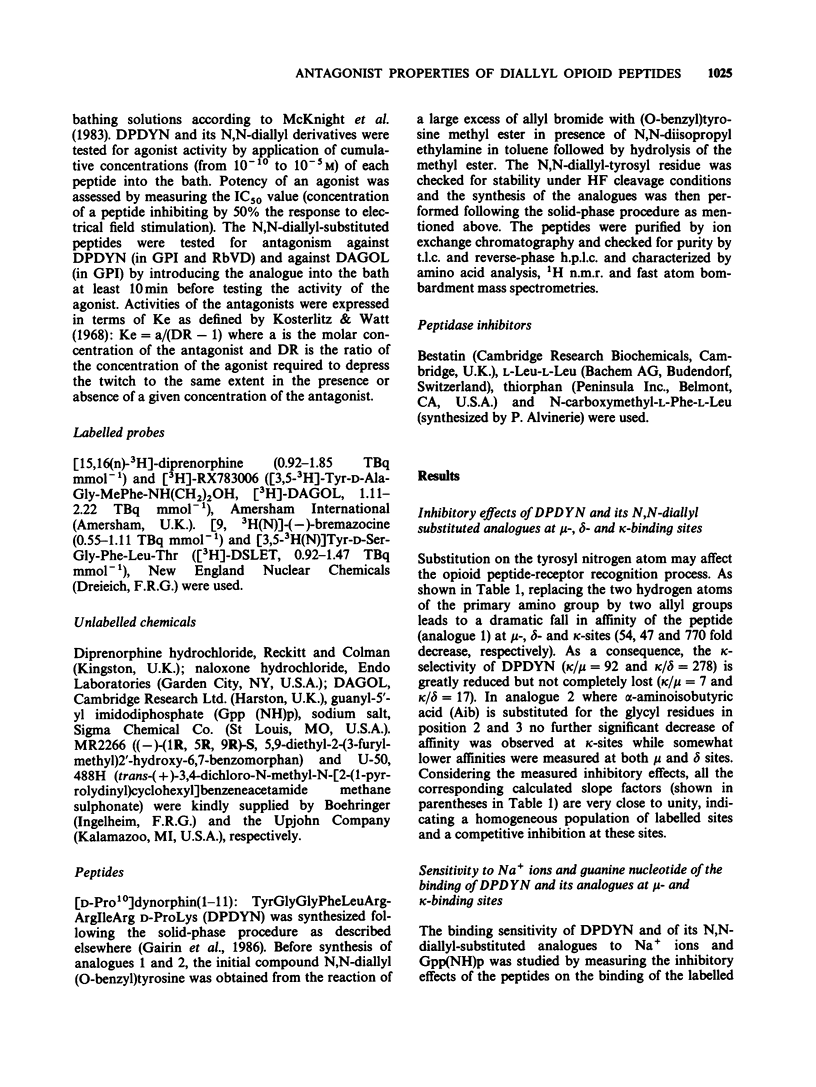Abstract
1. In the search for kappa-opioid antagonists, we have designed two N,N-diallyl substituted analogues of the kappa-selective peptide [D-Pro10]dynorphin A (1-11)(DPDYN). In this study, we have examined (i) the binding properties of N,N-diallyl-DPDYN (analogue 1) and N,N-diallyl-[Aib2,3]DPDYN (analogue 2) at the three main types (mu, delta, kappa) of opioid binding sites, (ii) their binding sensitivity to Na+ ions (120 mM NaCl) and guanine nucleotide (50 microM Gpp(NH)p) at mu- and kappa-binding sites and (iii) their biological activity in two pharmacological bioassays specific for mu- and kappa-(guinea-pig ileum) and kappa-(rabbit vas deferens) opioid receptors. 2. Steric hindrance resulting from incorporation of two bulky allyl groups at the tyrosal nitrogen atom greatly altered the binding properties of DPDYN. A dramatic fall in apparent affinity for the three types (mu, delta, kappa) of site as well as selectivity for kappa-sites was observed for the two N,N-diallyl-substituted peptide analogues. 3. At kappa-sites of guinea-pig cerebellum and mu-sites of rabbit cerebellum, N,N-diallyl-substitution led to a complete loss of binding sensitivity to the inhibitory effect of 120 mM NaCl + 50 microM Gpp(NH)p compared to the high sensitivity of DPDYN. This may therefore suggest that the N,N-diallyl-DPDYN analogues are endowed with opioid antagonist properties. 4. No agonist activity of the analogues was observed in guinea-pig myenteric plexus and rabbit vas deferens organ preparations. In contrast, both of the diallyl-substituted peptides displayed similar antagonist properties against the kappa-agonist DPDYN in both preparations.(ABSTRACT TRUNCATED AT 250 WORDS)
Full text
PDF







Selected References
These references are in PubMed. This may not be the complete list of references from this article.
- Bradford M. M. A rapid and sensitive method for the quantitation of microgram quantities of protein utilizing the principle of protein-dye binding. Anal Biochem. 1976 May 7;72:248–254. doi: 10.1016/0003-2697(76)90527-3. [DOI] [PubMed] [Google Scholar]
- Chavkin C., James I. F., Goldstein A. Dynorphin is a specific endogenous ligand of the kappa opioid receptor. Science. 1982 Jan 22;215(4531):413–415. doi: 10.1126/science.6120570. [DOI] [PubMed] [Google Scholar]
- Corbett A. D., Gillan M. G., Kosterlitz H. W., McKnight A. T., Paterson S. J., Robson L. E. Selectivities of opioid peptide analogues as agonists and antagonists at the delta-receptor. Br J Pharmacol. 1984 Sep;83(1):271–279. doi: 10.1111/j.1476-5381.1984.tb10143.x. [DOI] [PMC free article] [PubMed] [Google Scholar]
- Cotton R., Giles M. G., Miller L., Shaw J. S., Timms D. ICI 174864: a highly selective antagonist for the opioid delta-receptor. Eur J Pharmacol. 1984 Jan 27;97(3-4):331–332. doi: 10.1016/0014-2999(84)90470-9. [DOI] [PubMed] [Google Scholar]
- Frances B., Moisand C., Meunier J. C. Na+ ions and Gpp(NH)p selectively inhibit agonist interactions at mu- and kappa-opioid receptor sites in rabbit and guinea-pig cerebellum membranes. Eur J Pharmacol. 1985 Nov 5;117(2):223–232. doi: 10.1016/0014-2999(85)90607-7. [DOI] [PubMed] [Google Scholar]
- Gairin J. E., Gouarderes C., Mazarguil H., Alvinerie P., Cros J. [D-Pro10]Dynorphin-(1-11) is a highly potent and selective ligand for kappa opioid receptors. Eur J Pharmacol. 1984 Nov 13;106(2):457–458. doi: 10.1016/0014-2999(84)90741-6. [DOI] [PubMed] [Google Scholar]
- Gairin J. E., Mazarguil H., Alvinerie P., Saint-Pierre S., Meunier J. C., Cros J. Synthesis and biological activities of dynorphin A analogues with opioid antagonist properties. J Med Chem. 1986 Oct;29(10):1913–1917. doi: 10.1021/jm00160a019. [DOI] [PubMed] [Google Scholar]
- Gyand E. A., Kosterlitz H. W. Agonist and antagonist actions of morphine-like drugs on the guinea-pig isolated ileum. Br J Pharmacol Chemother. 1966 Sep;27(3):514–527. doi: 10.1111/j.1476-5381.1966.tb01864.x. [DOI] [PMC free article] [PubMed] [Google Scholar]
- Kosterlitz H. W., Paterson S. J., Robson L. E., Traynor J. R. Effects of cations on binding, in membrane suspensions, of various opioids at mu-sites of rabbit cerebellum and kappa-sites of guinea-pig cerebellum. Br J Pharmacol. 1987 Jun;91(2):431–437. doi: 10.1111/j.1476-5381.1987.tb10298.x. [DOI] [PMC free article] [PubMed] [Google Scholar]
- Kosterlitz H. W., Watt A. J. Kinetic parameters of narcotic agonists and antagonists, with particular reference to N-allylnoroxymorphone (naloxone). Br J Pharmacol Chemother. 1968 Jun;33(2):266–276. doi: 10.1111/j.1476-5381.1968.tb00988.x. [DOI] [PMC free article] [PubMed] [Google Scholar]
- Lemaire S., Turcotte A. Synthesis and biological activity of analogs of dynorphin-A(1-13) substituted in positions 2 and 4: design of [Ala2,Trp4]-Dyn-A(1-13) as a putative selective opioid antagonist. Can J Physiol Pharmacol. 1986 Jun;64(6):673–678. doi: 10.1139/y86-111. [DOI] [PubMed] [Google Scholar]
- McKnight A. T., Corbett A. D., Kosterlitz H. W. Increase in potencies of opioid peptides after peptidase inhibition. Eur J Pharmacol. 1983 Jan 21;86(3-4):393–402. doi: 10.1016/0014-2999(83)90189-9. [DOI] [PubMed] [Google Scholar]
- Meunier J. C., Kouakou Y., Puget A., Moisand C. Multiple opiate binding sites in the central nervous system of the rabbit. Large predominance of a mu subtype in the cerebellum and characterization of a kappa subtype in the thalamus. Mol Pharmacol. 1983 Jul;24(1):23–29. [PubMed] [Google Scholar]
- Oka T., Negishi K., Suda M., Matsumiya T., Inazu T., Ueki M. Rabbit vas deferens: a specific bioassay for opioid kappa-receptor agonists. Eur J Pharmacol. 1981 Jul 17;73(2-3):235–236. doi: 10.1016/0014-2999(81)90098-4. [DOI] [PubMed] [Google Scholar]
- Paterson S. J., Robson L. E., Kosterlitz H. W. Control by cations of opioid binding in guinea pig brain membranes. Proc Natl Acad Sci U S A. 1986 Aug;83(16):6216–6220. doi: 10.1073/pnas.83.16.6216. [DOI] [PMC free article] [PubMed] [Google Scholar]
- Pert C. B., Bowie D. L., Pert A., Morell J. L., Gross E. Agonist-antagonist properties of N-allyl-[D-Ala]2-Met-enkephalin. Nature. 1977 Sep 1;269(5623):73–75. doi: 10.1038/269073a0. [DOI] [PubMed] [Google Scholar]
- Portoghese P. S., Lipkowski A. W., Takemori A. E. Binaltorphimine and nor-binaltorphimine, potent and selective kappa-opioid receptor antagonists. Life Sci. 1987 Mar 30;40(13):1287–1292. doi: 10.1016/0024-3205(87)90585-6. [DOI] [PubMed] [Google Scholar]
- Portoghese P. S., Takemori A. E. TENA, a selective kappa opioid receptor antagonist. Life Sci. 1985 Feb 25;36(8):801–805. doi: 10.1016/0024-3205(85)90202-4. [DOI] [PubMed] [Google Scholar]
- Robson L. E., Foote R. W., Maurer R., Kosterlitz H. W. Opioid binding sites of the kappa-type in guinea-pig cerebellum. Neuroscience. 1984 Jun;12(2):621–627. doi: 10.1016/0306-4522(84)90077-0. [DOI] [PubMed] [Google Scholar]
- Shaw J. S., Miller L., Turnbull M. J., Gormley J. J., Morley J. S. Selective antagonists at the opiate delta-receptor. Life Sci. 1982 Sep 20;31(12-13):1259–1262. doi: 10.1016/0024-3205(82)90356-3. [DOI] [PubMed] [Google Scholar]


